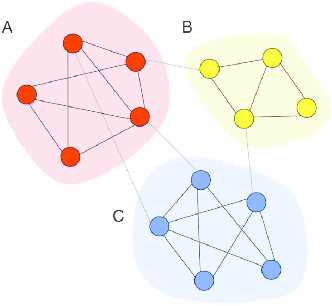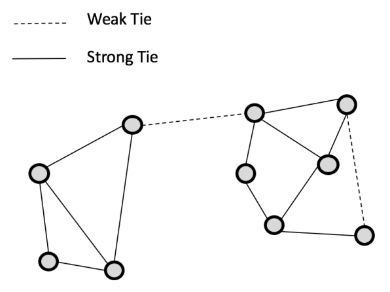The University of Notre Dame and Northwestern university undertook a study in which the social and communication networks of 700 past graduates were analysed. They focused specifically on 3 aspects: network centrality, gender homophily and strength of ties.

Network Centrality 
Network Homophily 
Tie Strength
Their research revealed that more than 75% of female graduates who had close, same sex friendship groups rose to top roles in their workplace. Essentially, the women who had high network centrality and a close, female inner circle (strong ties with two or three other females) were more likely to be found in higher roles than those less central, and with mainly male close friends. Males with high network centrality were also more likely to be in top-level positions, but unlike women, gender was not found to contribute significantly to this, neither did the strength of these ties.
This research explores a number of themes we have discussed in class. We can first look at the idea of flow of information. Why was high centrality a significant factor in both men and women? Perhaps it has something to do with how we find out about these roles. The more people we know and connect with, the more likely we are to find out about these opportunities.
“It’s not what you know, it’s who you know.”
-Unknown
But why does having close female friends indicate an increased likelihood of high-ranking positions in women? We discussed Granovetter’s idea that structurally embedded edges (close ties within a community) are redundant in terms of access to information. We also discussed the potential pitfalls in homophily, in that it provides us a restricted view of the world if most of our information comes from other already like-minded people. So why does it appear to be playing to our advantage in this case? It appears another factor is at play here, one seemingly unique to women.
I find it fascinating the amount of information about a person that can be found from network analysis. We’ve all heard the saying ‘show me your friends and I’ll tell you who you are’, but network analysis really brings a whole new dimension to that. Now, I don’t know about any of you reading this, but I’d certainly like a high-ranking position. Research is showing my job placement is likely to be 2.5 times greater than those without a large network and close female friends, so I’m off to Facebook to send friend requests to a few hundred people and interact heavily with two to three other females. Forbes list, I’m coming for you.

Side note: of course, all these things need to be taken with a pinch of salt. Yes, correlation doesn’t equal causation, but exploring these correlations to reveal potentially underlying causation is a whole other (but equally fascinating) thing.
Relevant Links
- https://www.instylemag.com.au/female-friendships-successful-career-study
- http://www.develop-project.eu/news/strength-of-social-ties-at-workplace
- https://aksakalli.github.io/2017/07/17/network-centrality-measures-and-their-visualization.html
- https://www.researchgate.net/figure/Homophily-social-network-structure-and-causal-mechanisms-A-depiction-of-three-network_fig1_303504899
